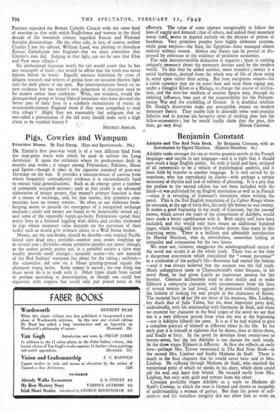Pigs, Cowries and Wampum
Primitive Money. By Paul Einaig. (Eyre and Spottiswoode. 25s.)
DR. EINZIG'S first post-war mirk is of a very different kind from the stop-press tracts with which he used to enliven the Long Armistice. It spans the millennia where its predecessors dealt in months and weeks ; it ranges among Polynesians, Eskimos, Masai end Igorot—though it takes in the cigarette standard of post-war Germany on the way. It provides a treasure-house of curiosa from whose frequently contradictory evidence it is extraordinarily hard to extract valid generalisations. Such as do emerge upset a number of commonly accepted notions ; such as that credit is an advanced elaboration of mo;iey proper, that money's primary function is that of a means of exchange, and, for that matter, that primitive com- munities have no money worries. 'Pis often as not elaborate book- keeping seems to precede the emergence of a recognised exchange medium ; credit and money are found to be inextricably mixed up ; and some of the reputedly happy-go-lucky Polynesians spend their entire lives in a frenzied juggling with debits and credits (reckoned in pigs whose monetary value depends on the curvature of their tusks) such as would give stomach ulcers to a Wall Street broker.
Money, say the text-books, should be durable—one tropical Pacific island uses dead rats ; portable—another uses stones weighing up to several tons ; divisible—many primitive peoples use slaves (though, as the author grimly points out, in a cannibal society a slave may readily provide small change) ; naturally scarce—the raw material of the Red Indians' wampum lies about for the taking ; uniform— the scrawniest old cow on a Masai grazing-ground equals the plumpest young heifer. Some money is sacred ; the one thing one must never do is to trade with it. Other types shade from sacred to profane according to denomination, as though one could buy cigarettes with coppers but could only put pound notes in the
offertory. The value of some appears recognisably to follow the laws of supply and demand ; that of others, and indeed their monetary status itself, seems to depend entirely on the dictates of priests or headmen. Very primitive peoples have highly elaborate systems, while great empires—the Inca, the Egyptian—have managed almost entirely without money. Almost any theory can be proved or dis- proved by reference to the evidence of primitive economies.
The only incontrovertible deduction is negative ; there is nothing uniquely necessary about the monetary devices used by the modern world. To this may be added another, more tentative ; money is a social institution, derikd from the whole way of life of those using it, acted upon rather than acting. But here exceptions swarm—for a cattle currency may eat its users bare and send them raging out, under a Genghiz. Khan or a Hulagu, to change the course of civilisa- tion, and the iron-bar medium of ancient Sparta may, through its isolating influence, bear part of the responsibility for the Pelopon- nesian War and the crumbling of Greece. It is doubtful whether Dr. Einzig's discoveries make any perceptible impact on modern monetary theory. They enable him to discredit some semi-popular fallacies and to pursue his favourite sport of sticking pins into his fellow-economists ; but he would hardly claim that the pins, this






































 Previous page
Previous page